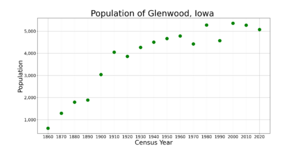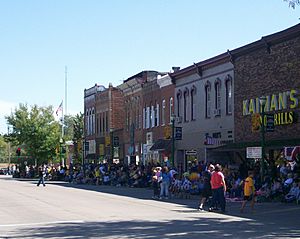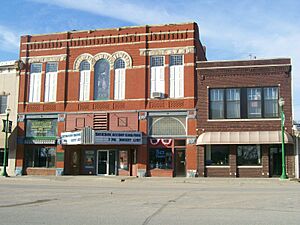Glenwood, Iowa facts for kids
Quick facts for kids
Glenwood, Iowa
|
|
|---|---|
|
City
|
|
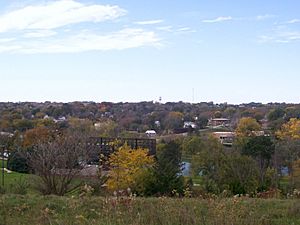
Looking west at Glenwood from Old Slaughterhouse Hill at the Glenwood Lake Park in 2007
|
|
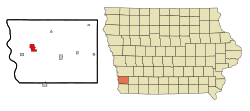
Location of Glenwood in Mills County and Iowa
|
|
| Country | United States |
| State | |
| County | Mills |
| Area | |
| • Total | 2.94 sq mi (7.60 km2) |
| • Land | 2.92 sq mi (7.57 km2) |
| • Water | 0.01 sq mi (0.03 km2) |
| Elevation | 1,017 ft (310 m) |
| Population
(2020)
|
|
| • Total | 5,073 |
| • Density | 1,735.55/sq mi (670.15/km2) |
| Time zone | UTC-6 (Central (CST)) |
| • Summer (DST) | UTC-5 (CDT) |
| ZIP code |
51534
|
| Area code(s) | 712 |
| FIPS code | 19-31350 |
| GNIS feature ID | 0456928 |
Glenwood is a city in Mills County, Iowa, United States. It is the main city, also known as the county seat, of Mills County. In the 2020 census, 5,073 people lived there. This was a small decrease from 5,358 people in 2000.
Contents
History of Glenwood
Glenwood is located in a valley of the Loess Hills, on the east side of the Missouri River. It was started by Mormons in 1848 and was first called Coonsville. The town grew quickly during the California Gold Rush. This was because of a grain mill on Keg Creek.
Coonsville faced some problems with anti-Mormon groups. In 1851, it became the county seat of Mills County. After most Mormons moved to Utah in 1852, the town was renamed Glenwood. It was named after a minister named Glenn Wood. The community also supported the creation of Nebraska Territory in 1854.
After the Civil War, a home for Iowa Veterans' Orphans was built here. The famous evangelist Billy Sunday lived at this orphanage when he was a child.
Glenwood's Growth and Industries
The Burlington and Missouri River Railroad reached Glenwood in 1869. In the late 1800s, Glenwood became famous for growing fruit, especially apples. The town even had an annual Apple Carnival.
Early businesses included an iron foundry and a large marble and stone works. There was also the Glenwood Creamery and a big cannery. This cannery was known for its "The Glenwood" brand. Another cannery, Darting & McGavern's "Sanitary," canned tomatoes, pumpkin, apples, and beets until the 1920s.
Glenwood Resource Center's History
In 1876, the State Veteran's Orphan's Home was changed. It became the Iowa Asylum for Children with Intellectual Disabilities. This was the seventh such facility in the country. It was also the first one west of the Mississippi River.
The Glenwood facility grew as more people accepted treatment for intellectual disabilities. It became the Iowa Institution for Feeble-Minded Children (IIFMC). By 1925, the IIFMC was home to 1,555 people. In 1941, it was renamed the Glenwood State-Hospital School. By the early 1950s, it covered about 1,185 acres. It had 310 staff members for 1,968 patients.
Changes began in the late 1950s to help people live more independently. A newspaper article in 1957 shared the story of Mayo Buckner. He had been at Glenwood for 59 years, even though he had above-average intelligence. This story brought national attention to Glenwood State-Hospital School. It was featured in Time Magazine and Life Magazine.
During the 1970s, the facility changed from large ward buildings to smaller, group home-style cottages. Today, it is called the Glenwood Resource Center. It helps people with intellectual disabilities learn skills to live in their communities.
Modern Glenwood and Transportation
After World War II, Glenwood became a center for meat-packing. In the early 1950s, it had one of America's largest kosher packinghouses. Most of its products were sent to New York and the East Coast. The packinghouse later processed both cattle and pork. It was bought by Swift & Company but closed in the 1980s.
Today, a whirlpool manufacturer called Trajet uses the old slaughterhouse building.
Glenwood has good transportation links. The BNSF train line passes through. U.S. Route 34 and U.S. Route 275 also go through Glenwood. Interstate 29 is just a few miles west, near the Missouri River. Tourists enjoy visiting the Loess Hills and the National Scenic Byway.
Geography of Glenwood
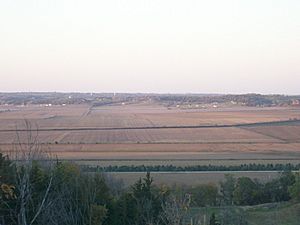
Glenwood is located at coordinates 41°2′44″N 95°44′33″W / 41.04556°N 95.74250°W. The United States Census Bureau says the city covers about 2.96 square miles (7.67 square kilometers). Most of this area, 2.95 square miles (7.64 square kilometers), is land. Only a small part, 0.01 square miles (0.03 square kilometers), is water.
Population of Glenwood
| Historical population | |||
|---|---|---|---|
| Census | Pop. | %± | |
| 1860 | 614 | — | |
| 1870 | 1,291 | 110.3% | |
| 1880 | 1,793 | 38.9% | |
| 1890 | 1,890 | 5.4% | |
| 1900 | 3,040 | 60.8% | |
| 1910 | 4,052 | 33.3% | |
| 1920 | 3,862 | −4.7% | |
| 1930 | 4,269 | 10.5% | |
| 1940 | 4,501 | 5.4% | |
| 1950 | 4,664 | 3.6% | |
| 1960 | 4,783 | 2.6% | |
| 1970 | 4,421 | −7.6% | |
| 1980 | 5,280 | 19.4% | |
| 1990 | 4,571 | −13.4% | |
| 2000 | 5,358 | 17.2% | |
| 2010 | 5,269 | −1.7% | |
| 2020 | 5,073 | −3.7% | |
| U.S. Decennial Census | |||
2020 Census Information
In 2020, there were 5,073 people living in Glenwood. There were 1,918 households and 1,220 families. The city had about 1,736 people per square mile.
Most residents (92.9%) were White. About 4.0% of the population identified as Hispanic or Latino. The average age in the city was 38.9 years. About 27.9% of residents were under 20 years old.
2010 Census Information
In 2010, Glenwood had 5,269 people. There were 1,883 households, with 1,243 being families. The population density was about 1,786 people per square mile.
Most people (96.8%) were White. About 2.7% of the population was Hispanic or Latino. The average age was 38.1 years. About 25.8% of residents were under 18 years old.
Education in Glenwood
The local school system for Glenwood is the Glenwood Community School District. Students from Glenwood can also attend Saint Albert Catholic Schools in Council Bluffs.
Landmarks and Interesting Places
- The IIFMC Girls Cottage at the Glenwood Resource Center was built in 1912. Today, the Glenwood Community School District uses it for offices. It is a well-known landmark in the town.
- The Glenwood Earth Lodge and Mills County Natural History Museum is a place to learn about local history.
- The IIFMC Hospital at the Glenwood Resource Center was built in the 1890s. It has interesting towers and arched balconies. This three-story brick building is now used for offices by the Glenwood Resource Center.
- The IIFMC Fire Station at the Glenwood Resource Center was built in 1903. It has a unique roof style.
- The VJ Meyer School Building at the Glenwood Resource Center was built in the mid-1950s. It was named after Dr. VJ Meyer, a superintendent. From 1992 to 2007, this building was the Glenwood Middle School. It is now part of West Elementary.
- The JV Hinchman Building at Sharp and Walnut Streets was finished in 1882.
- The 1920 Glenwood State Bank building at 12 North Walnut is known for its marble front. It was designed by J. Chris Jensen.
- The First Christian Church at 305 First Street was built in 1867. It has been a private home for many years.
- 411 Sharp is a unique two-story building from 1874. It is now the Loess Hills Maker Space.
- The Hubbell Home at 202 Locust was built in the early 1900s. It has a special Queen Anne style and an old stable now used as a garage.
- The Robinson Block at 102 South Walnut has architectural features from the 1800s.
- The Buffington Block at 420 1st Street was built in the 1890s. It has a very detailed top edge and seven arched windows.
- The Glenwood Public Library opened in 1907. It was partly funded by Andrew Carnegie. It is one of 48 Carnegie library buildings still used as libraries in Iowa.
- The Wheeler's Super Service Station at 102 South Vine was built in the early 1920s. It served traffic on the Bluegrass Highway.
- The Glenwood Opera House Block at 412-416 First Street was built in 1891. It started showing movies in 1908 and is still a movie theater today. Live performances stopped in the mid-1900s.
- The Mintle Company Building at 209 Sharp was built in 1947. It used to sell farm equipment and cars. Now, it is the Glenwood Police Department.
- Lilac Terrace is a neighborhood that grew after the "West Hill" school was built in 1868. It still has some interesting old homes. The Works Progress Administration helped build Glenwood High School in 1937. It later became Glenwood Junior High and is now part of West Elementary.
- The Glenwood Golf Course opened in 1964. It was designed by Tom Davis. In 1974, a man died on the course while looking for a ball near hole five. Some say he still haunts that hole!
- Seminary Hill is a neighborhood north of the Glenwood Courthouse Square. It developed after Western Iowa College opened in the late 1860s. This area has many of the town's main churches. These include the Glenwood First Congregational Church, the Saint John's Episcopal Church, and the Glenwood Baptist Church. The Glenwood Public Library, a Carnegie library, is also in this neighborhood.
- The Davies Amphitheater at Glenwood Lake Park is a popular outdoor music venue. It was built in 1980 with money from Charlie Davies, a local farmer. It hosts summer concerts every year.
Notable People from Glenwood
- Hiram Pitt Bennet, a political leader from Colorado
- Christian Beranek, a graphic novelist, actor, and producer
- Elmer Burkett, a U.S. Senator from Nebraska
- Alice Cooper, a sculptor
- Don Hall, a filmmaker who won an Oscar for Disney's Big Hero 6
- Curt Kaufman, a pitcher for the California Angels and the New York Yankees baseball teams
- Billy Sunday, a famous evangelist
- Otha Wearin, a U.S. Representative from Iowa
See also
 In Spanish: Glenwood (Iowa) para niños
In Spanish: Glenwood (Iowa) para niños


